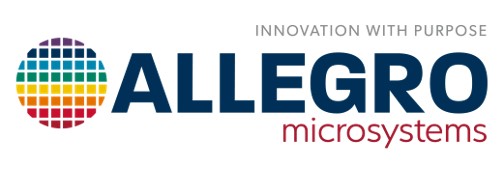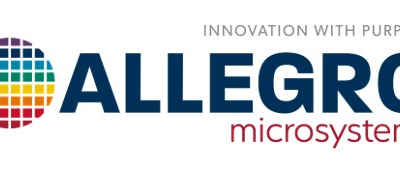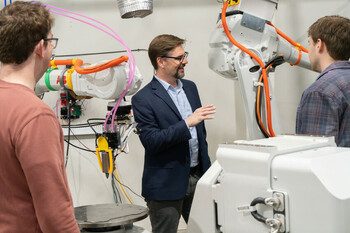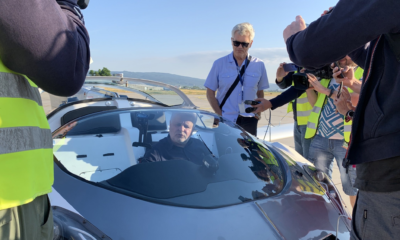Tech News
What is semi-automated offside technology and how does it work? – The Athletic

EPL
As Victor Torp sprinted toward the Wembley corner flag and fell onto his back, Coventry City looked like they had produced one of the greatest moments in FA Cup history.
Having been 3-0 down against Manchester United after 70 minutes, they had pulled off a remarkable comeback to lead 4-3 in stoppage time of extra time.
Advertisement
More than 36,000 Coventry fans were in euphoria and some Manchester United supporters left the stadium. The noise was deafening… but then came the silent wait for the VAR.
But 118 seconds after Torp had put the ball past Andre Onana, the goal was chalked off for the tightest of offsides as Coventry forward Haji Wright’s toe was judged to be slightly beyond Aaron Wan-Bissaka’s toe.
Championship side Coventry went on to lose 4-2 0n penalties, missing out on what would have been just their second FA Cup final appearance, having won it in 1987.
For a moment, Coventry City were in the FA Cup final.
But after scenes of utter sky blue jubilation, Victor Torp’s goal was ruled out by VAR. Penalties at Wembley it is, then.
📼 @itvfootball pic.twitter.com/sYEnJmJcXs
— The Athletic | Football (@TheAthleticFC) April 21, 2024
It led to widespread outcries on social media about the delay diminishing Coventry’s outpouring of emotion but also doubt being cast over the accuracy of the VAR’s call.
From next season, the Premier League will have technology that should see these gripes consigned to history: semi-automated offside technology (SAOT).
It is yet another acronym that fans will have to get used to after Premier League clubs unanimously approved the use of SAOT for the 2024-25 season, which is estimated to be available for use after one of the autumn international breaks.
Despite being in its fifth season, complaints about the time delays when the VAR has to study marginal offside calls still exist. In that context, the addition of SAOT feels like an important step.
The Premier League believes it will save an average of around 31 seconds per offside and there is the bonus of officials being instantly informed of the decision via an earpiece, which means an assistant referee can raise their flag as soon as they hear, rather than having to wait on the phase of play to come to an end.
Advertisement
But how does SAOT work?
The answer is: it depends. There is more than one path that leagues and competitions can take when implementing SAOT.
FIFA and UEFA use Hawk-Eye’s SAOT technology but FIFA uses the ‘connected ball’ add-on. Both require a camera-based optical skeletal tracking system, which uses video cameras to monitor around 30 joints on each player’s body.
The cameras automatically pick these up like antennas as soon as they go onto the pitch and its algorithms constantly calculate whether an attacker is in an offside position.
But the major difference between the two is that the latter uses the ‘connected ball’ and the Premier League does not intend to use that.
Munich-based Kinexon is the company that worked in conjunction with FIFA and Adidas for five years to produce 1,500 of these high-tech footballs for the men’s 2022 World Cup and 1,500 for the 2023 Women’s World Cup.
After its success, it will do the same for the men’s Euro 2024 and women’s Euro 2025 match ball called ‘Fussballliebe’ — German for ‘love of football’.
“Our in-ball chip is an advanced add-on for SAOT,” says Daniel Linke, product marketing and strategy lead at Kinexon.
“Using only an optical-based system has a greater error margin due to the shutter time of the camera, motion blur, picture angle and resolution.”
The standard broadcast cameras (used by VAR) record at 50 frames per second but Kinexon’s in-ball chip can judge when the ball has been touched 500 times per second.
With VAR in its current form, there is contention about whether the picture was frozen on the correct frame for offside calls — eg, working out the exact moment the ball had left Callum O’Hare’s boot for Coventry’s disallowed goal on Sunday — but this is where Kinexon’s in-ball chip can offer a more precise judgement.
“We’ve all watched games with VAR where play is interrupted and they spend five minutes looking, only to draw the wrong conclusion,” says Linke.
Advertisement
“It’s so tricky to see from the video images exactly when the ball is touched as the picture might be blurred or occluded. With our connected ball, you get that information instantly. It is in perfect synchronisation with the video signal; we have it down to one or two milliseconds.
“Then the camera system’s algorithms are constantly working to assess offside every time a touch signal is sent by the ball chip.”
Linke talks to The Athletic through one of FIFA’s example videos, which shows how the chip complements the cameras to provide virtually real-time offside calls.
“What you see in red is the touch signal,” he says. “There is a peak when the ball is touched and that means you can see the picture instantly.
“Every line you see is a frame. When we detect a touch we send this to the VAR software. Between two picture frames we have 10 data points from the ball whenever there is a touch, so when you see the video with the touches overlayed you click on the image and the line is drawn instantly on the correct frame.”
That high-resolution sensor allows it to detect a full-strength kick to a subtle graze undetectable to the naked eye.
“The chip’s other strength is that the sensor has an inertia measurement unit inside, which is basically an accelerometer,” he says.
“It has a high-resolution touch signal — so every time you kick it or a feather drops on it, you will see it. It’s critical for the offside technology.
“You can also tell when the ball has been touched but also if it has been touched. There was the example of Cristiano Ronaldo when he claimed he headed it but the technology proved he had not. They do it with sound in cricket (snickometer) but the idea is similar.”
GO DEEPER
Adidas insist technology shows Cristiano Ronaldo did not touch ball
Domestic leagues typically wait for the International Football Association Board (IFAB, the body that oversees the laws of the game) and FIFA to deploy new technology before it cascades down the football pyramid. FIFA trialled SAOT in the 2021 Arab Cup and Club World Cup before using it for the Qatar World Cup.
Advertisement
Its success meant it was retained for the 2023 Women’s World Cup, while Italy’s Serie A has used SAOT for the past 18 months.
Spain’s La Liga announced last October it will introduce SAOT from the start of the 2024-25 season — but how long before it is almost universally used like VARs?
“There are other ball providers following (Adidas) but it takes a year of research and development to find the best way to implement the sensor. You need to design it in a way that it does not affect the physics of the ball.”
A lot of testing is required to prove the concept is fail-safe and that the technology does not impact the game’s aesthetics. The nightmare scenario would be for a player to take a throw-in and hear the chip rattling around.
SAOT is generally less expensive than VAR because less manpower is needed to operate the system. It is fully automated and can be overseen by one operator, whereas VAR requires several people to manually find the right frame and apply the offside lines.
Could there be a double benefit of the chip helping to determine whether the ball is in play or not?
There have been two goals this season when blindspots in VAR’s camera inventory have been exposed. Unfortunately for Arsenal, both incidents (against Newcastle United and West Ham United) went against them.
GO DEEPER
Explained: ‘A disgrace’ – Gordon’s controversial winner for Newcastle vs Arsenal
VAR has access to all broadcast cameras but the number in operation varies across each match, so there is no uniformity across all 20 stadiums.
Hawk-Eye is the provider of goal-line technology and normally places cameras at the back of the stands or on the roof. Contrary to popular belief, no cameras are placed inside the goalposts or crossbar, so Hawk-Eye’s ability to triangulate the ball’s position to within an average of three millimetres in goal-line decisions is not applicable further along the byline.
Advertisement
“We had the same question in the World Cup with the Japan goal that people thought had gone out,” says Linke.
“People were asking us why we didn’t use our technology, but to determine whether the ball has crossed the line or not it needs to be sub-centimetre accurate.
“Our strength is in the refresh rate of when the ball is connected with. We can determine the position of the ball but it would only be accurate to within two, three, four or five centimetres.”
(Top photo: Ed Sykes/Sportsphoto/Allstar via Getty Images)
Subscribe to The Athletic for in-depth coverage of your favorite players, teams, leagues and clubs. Try a week on us.
Jordan Campbell reports on Arsenal and the Scotland national team for The Athletic. He spent four seasons covering Rangers where he was twice nominated for Young Journalist of the Year at the Scottish Press Awards. He previously worked at Sky Sports News and has experience in performance analysis. Follow Jordan on Twitter @JordanC1107
Tech News
Exploring Startup Opportunities In Alternative Fuel Technology – Forbes

In this article, we explore four startup opportunities in alternative fuel technology, ranging from … [+]
In the context of the ever-growing energy consumption demands of our global civilization, especially bearing in mind the rising living standards in some of the most populous areas in Asia and Africa, combined with the environmental impact of the energy sector, innovations in energy and fuel technology are likely some of the most important and impactful technological developments to look forward to in the coming decades.
With this in mind, if you are a startup founder looking to change the world for the better alternative fuel technology is a promising field to focus your energy on. Startups at the forefront of this movement have the opportunity to revolutionize the transportation sector and accelerate the transition to a sustainable future. Моreover, because of the environmental impact of such technologies finding funding for your startup could be easier because of the availability of public funding for green technologies in a generally favorable regulatory environment.
In this article, we’ll explore four startup opportunities in alternative fuel technology, ranging from electric vehicle charging infrastructure to biofuels, highlighting their potential for innovation and market disruption.
Electric vehicles (EVs) are becoming increasingly popular as consumers and governments prioritize cleaner transportation options. However, the widespread adoption of EVs hinges on the availability of reliable and convenient charging infrastructure.
Startups in this space can focus on developing innovative solutions such as fast-charging stations, wireless charging technology, and smart grid integration. For example, companies like ChargePoint and EVgo are pioneering the development of EV charging networks across the globe, catering to the growing demand for electric mobility.
The opportunity for startups lies in addressing key challenges such as scalability, interoperability, and user experience. By leveraging advanced technologies and strategic partnerships, startups can play a vital role in expanding EV charging infrastructure and accelerating the adoption of electric vehicles.
Battery technology is a critical component of alternative fuel technology, enabling energy storage for electric vehicles, renewable energy systems, and portable electronics. In fact, energy storage technology is becoming a choke-point for most of the mass adoption and practical feasibility of a lot of EV and alternative energy solutions.
Startups in this space can focus on developing advanced battery chemistries, materials, and manufacturing processes to improve performance, safety, and cost-effectiveness. For example, companies like Tesla and Panasonic are leading the charge in lithium-ion battery production, driving down costs and improving energy density.
The demand for high-performance batteries is expected to surge as electric vehicles and renewable energy installations continue to grow. Startups that can innovate in areas such as solid-state batteries, silicon-anode technology, and battery recycling have the potential to disrupt the market and capture significant market share. Moreover, advancements in battery technology can unlock new applications such as grid-scale energy storage and electric aviation, further expanding the market opportunity for startups.
Hydrogen fuel cells offer a promising alternative to traditional combustion engines, providing zero-emission power for various applications, including vehicles, drones, and stationary power systems. Startups in this space can focus on developing innovative solutions for hydrogen production, storage, distribution, and fuel cell technology.
For example, companies like Ballard Power Systems and Plug Power are leading the commercialization of hydrogen fuel cell technology for transportation and industrial applications.
The scalability and versatility of hydrogen fuel cells present a compelling opportunity for startups to drive innovation and market penetration. By overcoming technical challenges such as cost, efficiency, and infrastructure, startups can position themselves as key players in a possible transition to a hydrogen-based economy. Additionally, government incentives and industry partnerships can provide critical support for startups seeking to capitalize on the growing demand for clean energy solutions.
Biofuels offer a renewable alternative to conventional fossil fuels, derived from organic sources such as biomass, algae, waste materials, or agricultural residues. Startups in this space can focus on developing sustainable biofuel production processes that minimize environmental impact and maximize energy efficiency.
For example, companies like Renewable Energy Group and Gevo are leveraging advanced biotechnology and feedstock optimization to produce low-carbon biofuels for transportation and heating applications among others.
The abundance of organic feedstocks and the potential for carbon neutrality make biofuels an attractive option for reducing greenhouse gas emissions and mitigating climate change. Startups that can innovate in biofuel production, distribution, and certification have the opportunity to disrupt traditional energy markets and drive the transition to a more sustainable energy future. Additionally, government mandates and corporate sustainability initiatives create a favorable regulatory environment for biofuel startups to thrive.
Tech News
GHSP Leverages Allegro MicroSystems' Technology to Shift – GlobeNewswire

| Source: Allegro MicroSystems, Inc.
MANCHESTER, N.H., April 30, 2024 (GLOBE NEWSWIRE) — Allegro MicroSystems, Inc. (“Allegro”) (Nasdaq: ALGM) a global leader in power and sensing semiconductor technology for motion control and energy efficient-system is pleased to announce, that GHSP, a global provider of mechanical and electromechanical systems and portfolio company of JSJ Corporation, is closely collaborating with and has adopted Allegro’s best-in-class gate driver and vehicle sensor technology for its new eVibe vibration enhancement system.
In the rapidly evolving world of xEV technology, there is a new class of xEV enthusiasts who crave a more immersive motoring experience. GHSP’s eVibe system transforms xEV driving by providing drivers with the noise and vibrations that mimic the familiar feel and sounds of a traditional internal combustion engine. At the heart of this next-level technology, is Allegro’s A89500 motor driver and APS12215 Hall-effect latch, which provide best-in-class performance and switching capabilities.
“From the beginning, our challenge has always been to create a solution that would address a unique and growing xEV market segment,” said Dan Dawiedczyk, President of GHSP. “We are excited to collaborate and combine our industry experience and expertise, to help bring our vision to life. Together, Allegro and GHSP are developing groundbreaking innovations. We look forward to a winning partnership for many years to come.”
Helping to elevate the end product, Allegro’s A89500 motor driver allows for high power density and fast switching to help provide instant response and feel. Its transient robustness and wide input voltage range make it a standout solution in the market. The APS12215 Hall-effect latch, on the other hand, provides high-temperature performance and stable switching capabilities, enabling the eVibe system to precisely track and monitor the position of the motors’ unbalanced weights, ultimately leading to a more realistic vibration experience. The eVibe technology allows several applications including ADAS, ICE emulation, or high performance.
“For more than a decade, Allegro has worked closely with market-leading automotive partners to develop innovative solutions that help shift the future of driving, power and performance in electric vehicles,” said Suman Narayan, Allegro’s Senior Vice President, Products. “Our latest collaboration highlights a new, growing market segment and demand for Allegro’s technology. We value GHSP’s automotive expertise and look forward to our continued partnership as we develop solutions that drive innovation.”
The impact of eVibe extends beyond just the driving experience. It represents a shift towards the future of xEV technology and the way owners engage with their vehicles. From mimicking an idle feel to simulated engine throttle and high-speed gear shifts via premium vibration indicators, GHSP’s technology is providing drivers with a more immersive and connected drive. This innovation has the potential to reshape the xEV market, catering to a wider range of custom options and individual customer preferences, while also helping to further the adoption of electric vehicles.
On Thursday, May 2, GHSP and Allegro will host a virtual round table discussing “The Evolution of eVibe with GHSP and Allegro MicroSystems.” To learn more and register for this event please visit: https://allegromicro.com/en/applications/automotive
For more information about the eVibe system please visit: https://www.ghsp.com/evibe
About Allegro MicroSystems
Allegro MicroSystems, Inc. is a leading global designer, developer, fabless manufacturer and marketer of sensor integrated circuits (“ICs”) and application-specific analog power ICs enabling emerging technologies in the automotive and industrial markets. Allegro’s diverse product portfolio provides efficient and reliable solutions for the electrification of vehicles, automotive ADAS safety features, automation for Industry 4.0 and power-saving technologies for data centers and clean energy applications. For additional information, please visit https://www.allegromicro.com/en/.
About GHSP
GHSP is a privately owned company based in Grand Haven, Mich., that specializes in the design and manufacturing of innovative control systems and technology solutions primarily for the automobile and high-end appliance industries. Founded in 1924, GHSP has locations in North America, Europe and Asia. GHSP is a portfolio business within JSJ Corporation, a growth firm with global manufacturing, distribution and service businesses that focus on highly technical skills to deliver engineered solutions. Learn more at GHSP.com and JSJcorp.com.
Allegro Contact:
Laura Kozikowski
Sr. Director of Global Marketing and Corporate Communications
[email protected]
GHSP Contact:
Liz Hoffswell
Marketing & Communication Leader
[email protected]
Tech News
BAE Systems' electric drive technology to power GILLIG's new hydrogen fuel cell transit buses for zero-emission … – BAE Systems
-

 General Knowledge2 years ago
General Knowledge2 years agoList of Indian States and Capital
-

 General Knowledge2 years ago
General Knowledge2 years agoList Of 400 Famous Books and Authors
-

 Important Days4 years ago
Important Days4 years agoImportant Days of Each Month
-

 General Knowledge2 years ago
General Knowledge2 years agoCountries and their National Sports
-

 General Knowledge3 years ago
General Knowledge3 years agoCountry Capital and Currency
-

 Important Days3 years ago
Important Days3 years agoHoli
-

 General Knowledge2 years ago
General Knowledge2 years agoList of Indian President
-

 General Knowledge2 years ago
General Knowledge2 years agoList of Indian Vice President













